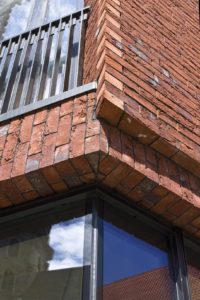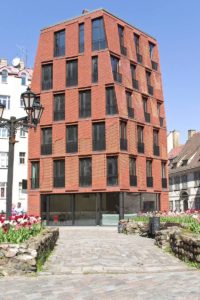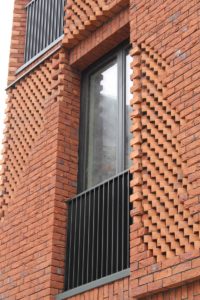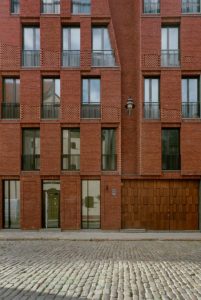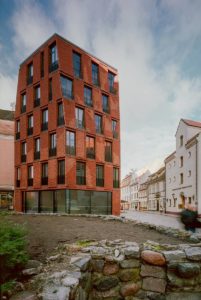Building a new in our century within the Old Town of Riga in Latvia, it’s either too blank or too obvious.
New architecture in the Old Town is still rather rare and not much loved in the eyes of locals and visitors alike, who both prefer the safe, postcard look of a Hanseatic town. A new residential building at Skarnu Street, however proves that contemporary architecture can work well in this historic context. It is bold, beautiful, and clad in red brick, a much-loved but forgotten material that has been used in the region for centuries. Ieva Zībārte details the emergence of this project by local architects Jaunromāns un Ābele.
This brick building with six apartments and commercial space on the ground floor was designed and built over a decade. Situated right in the middle of the city, it exhibits five playfully yet strongly organized facades towards some of the most famous pieces of local heritage, including the 13th-century St. John’s Church, the oldest church in Riga and St. Peter’s Church.
Most buildings situated in Riga’s Old Town are protected three-fold – by the city, the state, and UNESCO (the Old Town and its surrounding area is a World Heritage Site). This new building is even more special: many argue this is the oldest spot in town, and that the entire history of local architecture started right here.
In 2006, an international architecture competition was announced and organised by Decarta Property to find the best possible design for a new residential building on the 175 m2 plot. The aim of the competition was to create a building with exclusive sculptural qualities that would blend in, but also complement the complex urban area.
First prize went to a then newly established studio, Jaunromāns un Ābele. As Andris Kreislers, representative of Decarta Property, recollects, ‘The biggest challenge at that time was the responsibility to get the right architecture for this particular place and time. That is why we organised an international competition. We had to get it right.’ A couple of years after the competition and the first stages of design, the economic downturn set in and everything stopped for a while. Luckily, neither the plot was sold or the idea cancelled and the project went on when times turned for the better.
Asked about the methodology of the design, both architects agreed it was very hands-on, with dozens of models, including one of the whole square being built during various stages of design. ‘Model making is very important to us,’ explains Mārtiņš Jaunromāns. ‘Only by working and reworking all ideas and options that could possibly be suitable for the place, can we be sure there are no compromises.’ After the structural walls were ready, the brick samples were brought to the building site and put in the window openings to see how they would look in real life, day and night. ‘The process of choosing the right building materials at some points was exhausting,’ Jaunromāns continues. ‘But we are at peace now; the choice was right, brick was our first and our last option.
The in-and-out brick pattern on the facade is inspired by a sculpture depicting the famous Town Musicians of Bremen: a donkey, dog, cat, and rooster standing on top of each other. Located close to 11 Skarnu Street, the sculpture was a gift from Riga’s twin city of Bremen, Germany.
The architects did not want the facade to remain plain, yet the irregular architectural patterns they tried to elaborate felt unrelated to the situation. The solution came together with the help of a graphic designer, who then copied the silhouettes of the ‘musicians’ to add both humour and context to the brick graphics.
Each level has a single function: a commercial space on the ground floor, one apartment on each of the levels 2 to 5, plus a top floor apartment with an extension and terrace on level 7. Each of the apartments offers a splendid 270-degree view, as well as wooden French windows in metal frames and small balconies.
Although the brick for the facade was chosen from a catalogue without any custom-made interventions, it was the intention of the architects that made it a little special in the context of the chosen material. ‘We spent hours establishing the right direction: the dimensions, the facture and the colour,’ Jaunromāns remembers. ‘There was an option to go light with the colour, there was an option to go black, since we did not want the colour to match the historical brick.’ Samples were ordered from the brick makers at Vandersanden Group and discussed at both the office and the building site, only to discover that the best choice would also be the most predictable and traditional for this, the oldest part of Riga. An important point was that all bricks were tested for frost resistance, as the thermometer can drop down to as low as -35° C in Latvian winters.
Project Details:
Architect: Jaunromāns un Ābele (Mārtiņš Jaunromāns, Māra Ābele, Ieva Skadiņa, Jolanta Šaitere, Liene Daņilēviča)
Client: Dekarta Property
Brick: Boston (n° 86), Vandersanden Group
Graphic designer: Edgars Zvirgzdiņš
Construction engineers: IG Kurbads, Bautopas
Facade and roof construction: Kokneši Plus
Windows: Aile
Address: Skārņu iela 11, Riga


